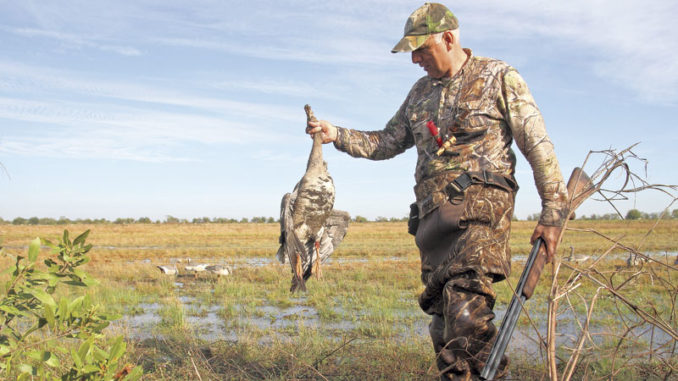
With specklebellies occupying more attention from waterfowl hunters, especially around Gueydan, don’t take any chances. Cover all your bases.
When it comes to waterfowl hunting locations, finding or choosing one can be like a game of “duck, duck, goose.”
You go around in circles until you think you’ve chosen just the spot you want to hunt. Then, suddenly, you find yourself in a desperate game of chase with fewer birds, educated birds and with competition not seen anywhere else along the Mississippi Flyway.
Essentially, by the time mid-December rolls around, ducks and geese have been hunted for three months, from Canada to Louisiana.
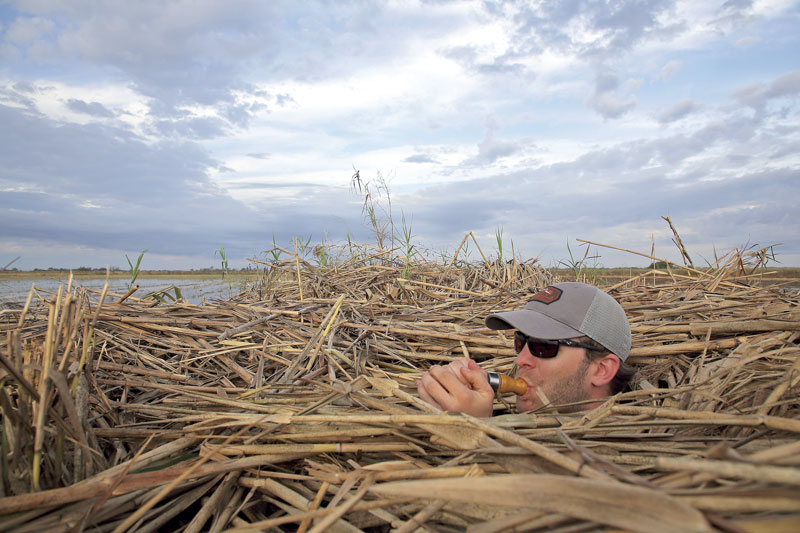
They have been enticed into gun range by some of the best callers in the flyway and sky-busted by the unethical. They’ve been lured, coaxed, tricked and tempted. They’ve been duped, seduced and inveigled.
In Vermilion Parish, the town of Gueydan, population 1,328, is known as the “Duck Capital of America” — and rightfully so. For more than a century and several generations, the town founded by Jean Pierre Gueydan in the late 1800s was surrounded by rice fields and coastal marsh. It was a mecca for waterfowl that migrated to the region annually.
But over the past three decades, much of that has changed, with coastal wetlands loss as well as changes in agricultural practices, where sugar cane and crawfish ponds are encroaching more and more in southwest Louisiana.
Increased hunting pressure in the region is a growing problem, too, where a hunting blind on nearly every 100 acres of land is common. And finally, climate change has impacted the duck migration, causing some hunters to see fewer birds during the season.
Despite the challenges, Gueydan remains a waterfowl hotspot year-in and year-out, with both private- and public-land producing average to above-average harvests.
One thing the changes have brought to the region is less attention on ducks and more of a focus on white-fronted geese. John Saucier, owner/operator of Sportsman’s Charters in Gueydan, and one of his top guides, Jack Cousin, have both seen a thing or two over the years when chasing specklebellies during a long season.
They point out that much of their focus is paying attention to three things when it comes to speck hunting: concealment, decoys and calling. That said, if you concentrate on these things for white-fronted geese, they will also help put ducks on your strap as well.
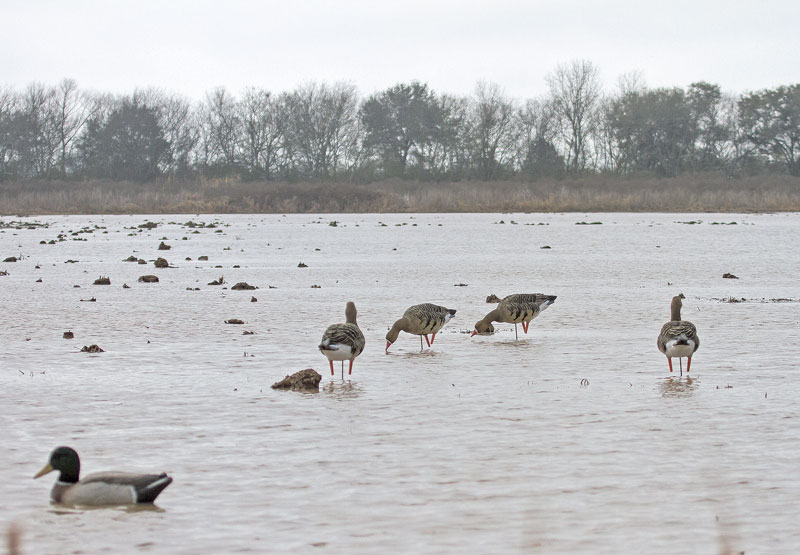
Concealment is no. 1
What you do the whole season matters at the end.
“Concealment is No. 1, for sure,” Saucier said. “I tell people all of the time, ‘You take care of your blinds to a certain extent the whole season, from Day 1 to Day 74, because what you do the whole season matters at the end.”
Saucier recommends that hunters take extra care of the natural vegetation that grows on their levees.
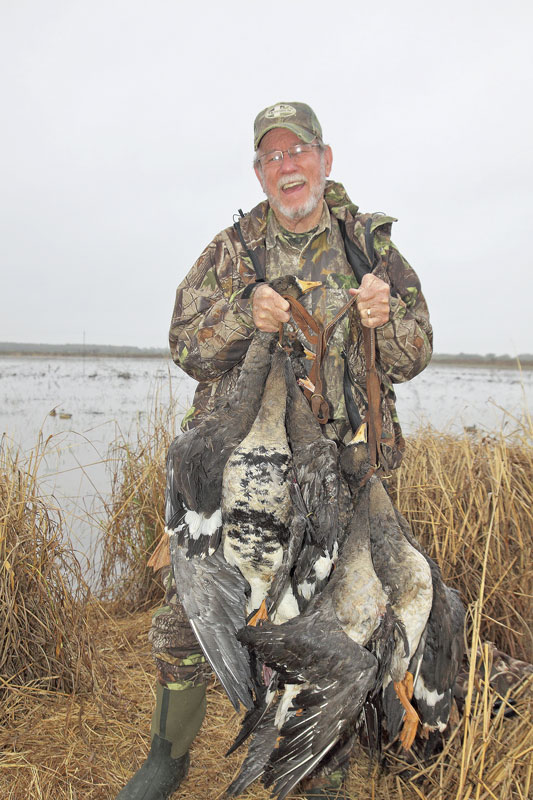
“You don’t want to be riding all over your levees with your 4-wheelers,” he said, “and you sure don’t want to be letting people walk circles around your pit blind, mashing down the grass and vegetation, so you give them a designated area to stand and walk to the blind.
“With your 4-wheelers,” he said, “you want to hug the levee and drive parallel to it all the way to the blind when dropping off people. You drop them off, drive past, turn around and take the same track out that you came in on. You don’t want 4- wheeler tracks all over the place out in front of your blind.”
Cousin and other guides are constantly digging up and cutting new brush throughout the year to keep things natural as winter frosts knock vegetation down.
“We’re hunting these levees over the course of a whole season, so we think about that and what kind of preparations do we have to make to maintain it,” he said. “You start thinking about it and getting into a habit of doing it during the early teal season. You have to think about what’s down the road in order to be successful through the whole season.”
Another point Saucier makes is to brush your blind to match the natural habitat you’re working with.
“If we’re hunting a ryegrass or winter wheat field that has winter wheat on it, we’re going to use cedar branches, because they’re the closest match to the habitat we’re hunting on,” he said. “By contrast, if we’re hunting Johnson grass, then we’re going to be digging a lot of clumps of it and making it all naturally blend in with the levee where the pit blind is.”
Cousin said most people have a blind or two, while outfitters like Sportsman’s Charters have 12. Each blind has to be approached differently when it comes to concealment.
“You might have some spots with no levee grass hardly at all,” Cousin said. “You have to figure out a way to brush the blind low-profile. You don’t want it sticking out like a sore thumb; specks do figure that out. In other words, you just can’t brush them all the same, across the board. A lot of people think some of the things we say are absolutely crazy and often razz us, saying, ‘You brushed that blind 19 times this year.’ I think a lot of people think that’s overkill, but it isn’t.”
Cousin summed up concealment by saying you don’t want any irregularities between where you’re hiding and what everything else looks like. He remembers one time when a flock of white ibis flared when passing over his blind. “If you can’t brush a blind where a white ibis can’t see you, how do you expect a specklebelly not to spook?”
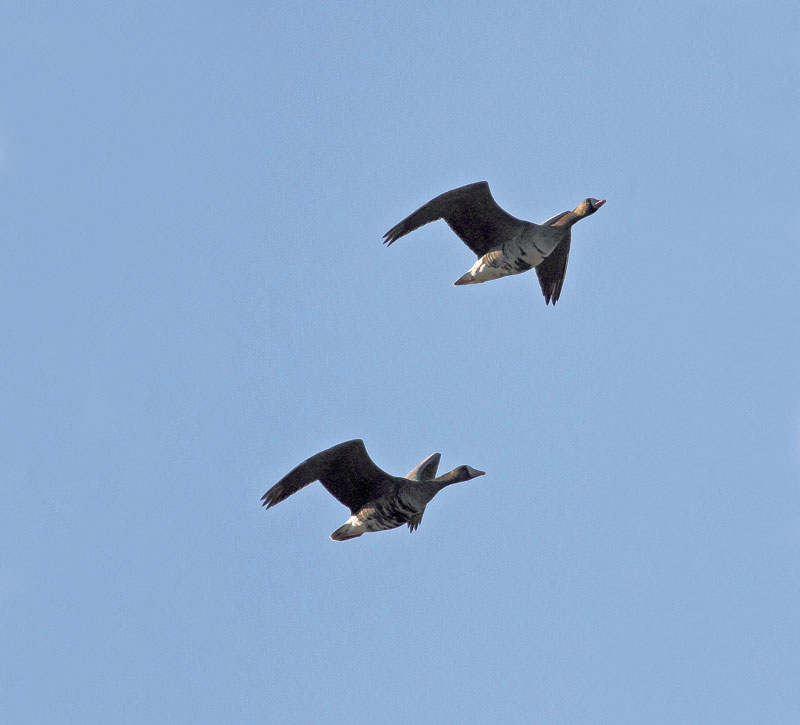
Decoys A to Z
You wouldn’t think white-fronted geese are that smart, but they don’t live to be 20 years old because they’re dumb.
Anyone who knows a birder knows they often use a playback call to attract the species they want to view. With pinpoint accuracy, a warbler, vireo or bunting can locate the source of the sound. Waterfowl are no different. The question is, what will they see?
“Using high-end, fully flocked decoys is a good place to start,” Saucier said. “You don’t want to use old, beat-up or faded decoys. We also tend to use fewer decoys late in the season. There are days we’ll use just five, six or maybe eight decoys and place them upwind from us.
“The way you trick those late-season birds is not calling until those geese are directly downwind from you. They know exactly where that sound is coming from, so you want to make them think it’s coming from the decoys. You wouldn’t think white-fronted geese are smart, but they don’t live to be 20 years old because they’re dumb.”
Saucier and Cousin said it’s not all about making noise and note that late-season specks will often make multiple passes before committing. What’s more, it’s about steering them. Therefore, they caution hunters not to overcall.
“If they’re coming in an area, and they’re already looking at your decoys and loafing across 50, 60, 70 yards high, almost in gun range, it could be three notes, it could be three clucks, it could be a long call and two clucks to finish them,” Saucier said. “Some people get to where it’s all about making noise. That works up north, because they’re hunting birds that aren’t getting shot. Pressure is what we have down here. “
Saucier said that fully flocked decoys come darker than standard plastic decoys and therefore don’t shine. He emphasized that you don’t want any glare coming from your decoys.
The downside to flocked decoys is they are more fragile and require more care when being handled.
Additionally, one thing Cousin and Saucier do after the first split of the season is clean their decoys. They also clean them whenever they get muddy. They also spend time painting and touching up plastic decoys when necessary.
And they never leave their decoys out.
“In the late season, we’re hunting smaller spreads. We’re picking up decoys daily and never leaving them out. And we’re making sure they’re cleaned daily,” Saucier said, emphasizing the little details and length they go to being successful.
Dealing with pressure
In the end, laziness doesn’t kill them
The area around Gueydan has some of the best specklebelly goose callers in the nation. Additionally, with blinds leasing for big money, it’s not uncommon for them to be no more than 100 acres apart.
Besides some of the best callers, hunters are also using some of the best decoys.
“You have to manage your pressure. You should let your blinds rest,” Saucier said. “Most of the blinds around Gueydan can only take three or four days of hunting per week; more than that you’re not going to kill anything. The birds are just not going to go there when there’s too much pressure. In the end, laziness doesn’t kill them. It’s all about being consistent, following the same pattern you use in the first part of the season and not over-pressuring birds.”
Public opportunity
There are public-hunting opportunities around Gueydan. One is White Lake Conservation Area down Highway 19 where lottery hunts for both ducks and geese are held.
Gueydan has always been a coastal hotspot for ducks and geese until recent years, when white-fronted geese have become more of the focus. No matter, it’s a region with plenty of birds. Just remember it can be like a game of “Duck-Duck-Goose.” Make sure you choose wisely…
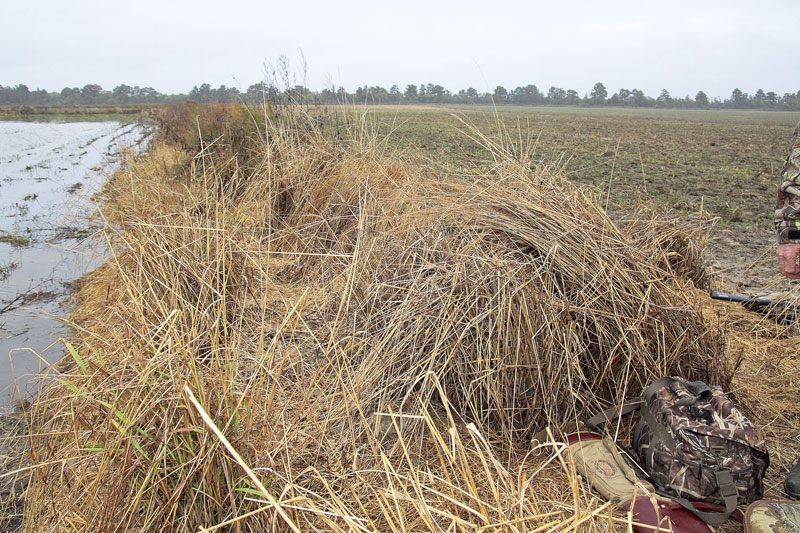
10 keys to successful specklebelly hunting
- Concealment is the most-critical aspect of successful hunting. Brushing blinds to the natural height of the levee and keeping them up through the season is important.
- Protect your levees and keep vegetation looking natural throughout the season.
- Line up your decoy spread with the wind.
- Don’t overcall late in the season; specklebelly geese have been called by some of the best callers in the flyway. It’s not about making noise.
- Fully flocked decoys often work better than standard plastic ones; white-fronted geese are in full winter plumage and tend to be darker feathered in the late season.
- Don’t use your 4-wheeler to chase cripples; it muddies the field in front of the blind, causing it to look unnatural.
- Pick up your shells and don’t leave them around the blind. Empty shotgun shells shine and can spook wary geese.
- Go the extra distance and hide your 4-wheeler as far from the blind as you can. Left too close, it can cause geese to flare.
- Keep your decoys clean and natural looking.
- Don’t leave your decoys out; pick them up after each hunt.